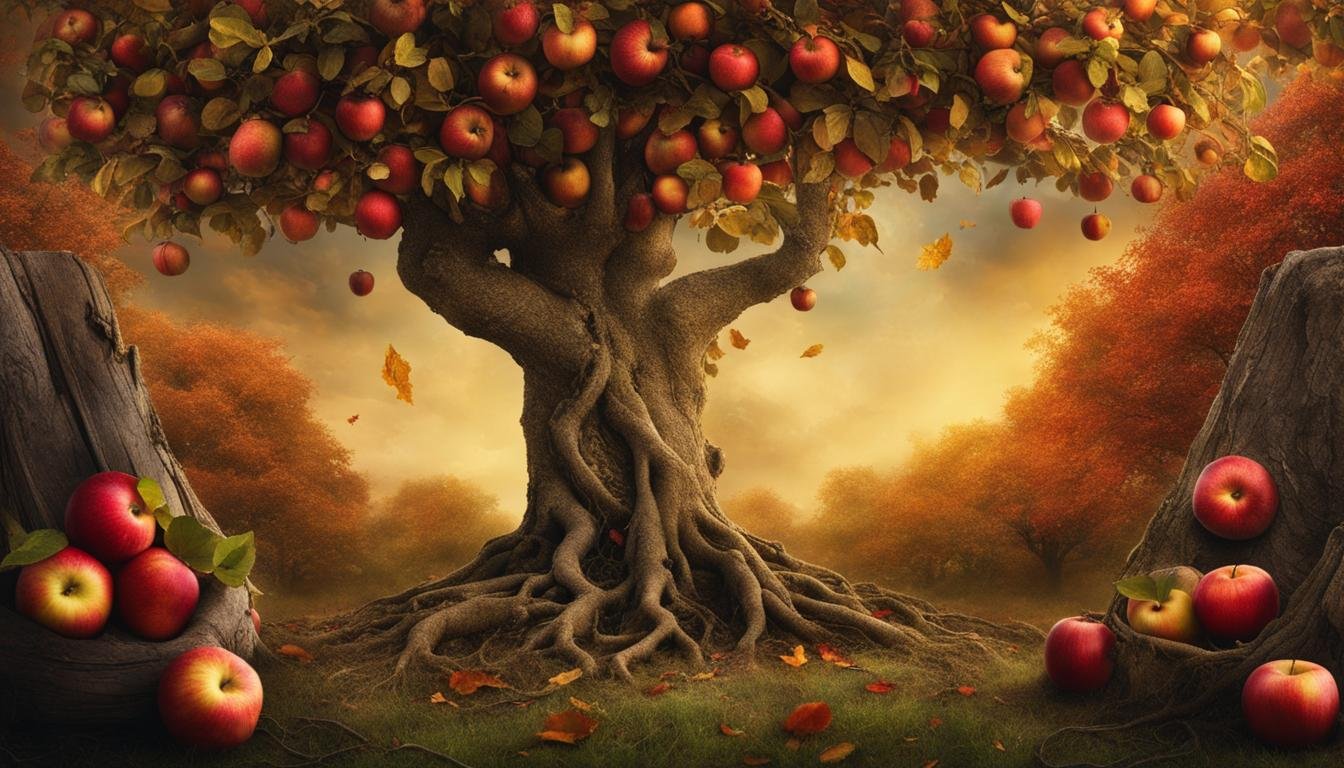Folklore about apple trees has captivated generations, weaving a rich tapestry of stories and beliefs that reflect the cultural heritage of the United States. From myths and legends to symbolism and superstitions, apple tree folklore offers a glimpse into the historical significance and deep-rooted traditions surrounding these iconic trees.
Key Takeaways:
- Apple tree folklore encompasses myths, legends, symbolism, and superstitions.
- Historical beliefs and cultural significance surround apple trees in the United States.
- Johnny Appleseed is a prominent figure in American apple tree folklore.
- Apple trees have connections to Native American culture and early American settlers.
- Apple tree preservation and conservation efforts are ongoing.
The Apple Tree’s Discovery – A Tale of Self-acceptance
In the story “The Apple Tree’s Discovery,” a little apple tree grows in the midst of majestic oaks and becomes jealous of their beauty. However, through a happy discovery, the apple tree learns to appreciate its own unique qualities and realizes that everyone is special in their own way. This tale teaches the importance of self-acceptance and celebrates individuality.
“And so, as the little apple tree gazed at its reflection in a nearby brook, it noticed something extraordinary. Its branches were adorned with beautiful blossoms, delicate and fragrant. It had its own special charm that no oak tree could match. From that day forward, the apple tree embraced its uniqueness and lived a life filled with joy, spreading its beauty and sweetness to all who encountered it.”
The tale of “The Apple Tree’s Discovery” serves as a reminder that true beauty lies in accepting oneself and celebrating what makes us different. Just like the apple tree, each of us has our own unique qualities that should be embraced and cherished. In a world that often values conformity, this story encourages us to stand tall and appreciate the beauty that comes from being true to ourselves.
As we navigate through life, it is important to remember that we are all like the apple tree, with our own set of strengths and weaknesses, successes and failures. Self-acceptance allows us to grow and thrive, just like the apple tree blossoming into a beautiful tree laden with juicy fruits. This tale of self-discovery serves as a gentle reminder to love and accept ourselves, embracing the beauty of our individuality.
The Apple Tree’s Discovery: Key Takeaways
- “The Apple Tree’s Discovery” is a story that highlights the importance of self-acceptance and celebrates individuality.
- The tale reminds us that true beauty lies in embracing our unique qualities and appreciating what makes us different.
- Just like the apple tree, each of us has our own set of strengths and weaknesses that should be celebrated.
- Self-acceptance allows us to grow and thrive, embracing the beauty of our individuality.
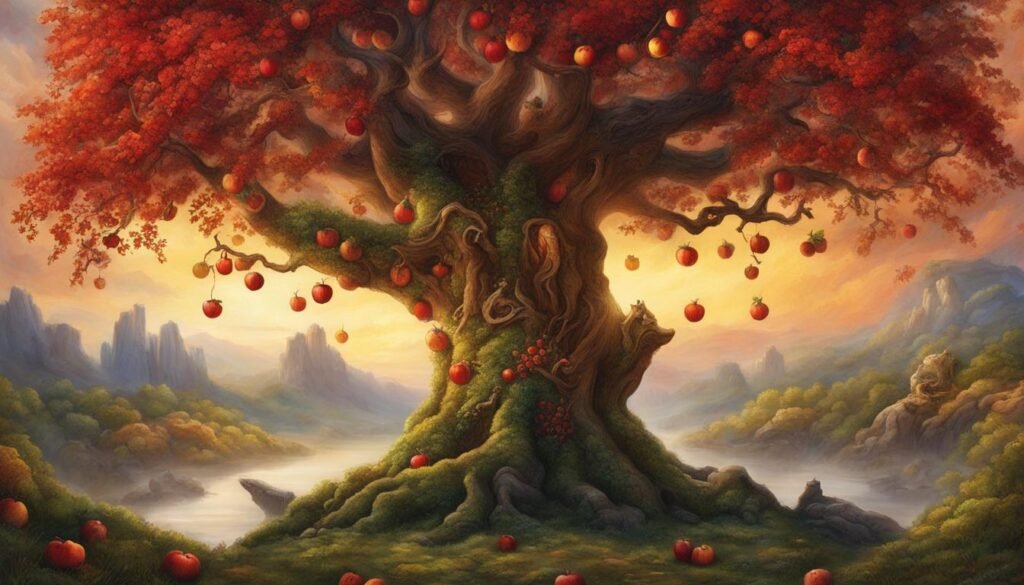
The Legacy of Johnny Appleseed
Johnny Appleseed, also known as John Chapman, is a legendary figure in American apple tree folklore. Contrary to popular belief, he was not just a barefoot wanderer who planted apple seeds but a skilled orchardist and nurseryman. He traveled extensively, planting orchards and selling them to settlers, ultimately owning over 1200 acres of land. His legacy extends beyond apple trees, as he also fostered relationships with Native Americans and valued the importance of nature and compassion in his life.
One of the most enduring myths about Johnny Appleseed is that he wandered the countryside randomly scattering apple seeds. In reality, he carefully selected and planted nurseries of apple trees, which he then sold to settlers. His goal was to provide apple trees for both food and drink, as apples were a staple food source and the foundation of the hard cider industry at the time.
Johnny Appleseed’s interactions with Native Americans were not just focused on apple trees. He forged friendships and mutual respect with Native American tribes, often trading apple trees for goods and services. He recognized the importance of indigenous knowledge and incorporated Native American medicinal plants and herbs into his plantings, demonstrating his respect for the land and its native inhabitants.
The Importance of Apple Trees in Early America
In early America, apple trees played a vital role in the lives of settlers. They were not only a source of sustenance but also served as a symbol of resilience and adaptation in the New World. The 1801 Act allowed settlers to claim land by planting apple or pear trees, making apple orchards a significant part of the landscape.
Although the apples planted by settlers were not always suitable for eating, they were perfect for making hard cider. During this time, the drinking water conditions were often unsafe, and hard cider became a popular alternative. Apple trees provided a reliable source of this beverage, ensuring that settlers had access to a safe and enjoyable drink.
This historical belief in the importance of apple trees is a testament to their cultural significance. They were not just trees – they represented survival, adaptation, and the ability of individuals to create a new life in a foreign land. The apple tree became a symbol of the settlers’ determination and their willingness to embrace the challenges of their new surroundings.
The Role of Apple Trees in Early America
The role of apple trees in early America can be summarized in the following table:
| Role | Description |
|---|---|
| Land Claim | Settlers could claim land by planting apple or pear trees. |
| Source of Hard Cider | Apples were used to make hard cider, a popular alternative to unsafe drinking water. |
| Symbol of Resilience | Apple trees represented the settlers’ ability to adapt and thrive in a new environment. |
Through their reliance on apple trees, early Americans not only created a sustainable source of food and drink but also embraced the symbolic meaning behind these resilient trees. Today, the legacy of apple trees in early America continues to be celebrated, reminding us of the ingenuity and perseverance of our ancestors.
Native American Connections to Apple Trees
Native Americans have a deep connection to the apple tree, recognizing its value not only as a source of food but also as a symbol of cultural significance. The apple tree’s presence in Native American folklore and traditions is a testament to its importance in their lives.
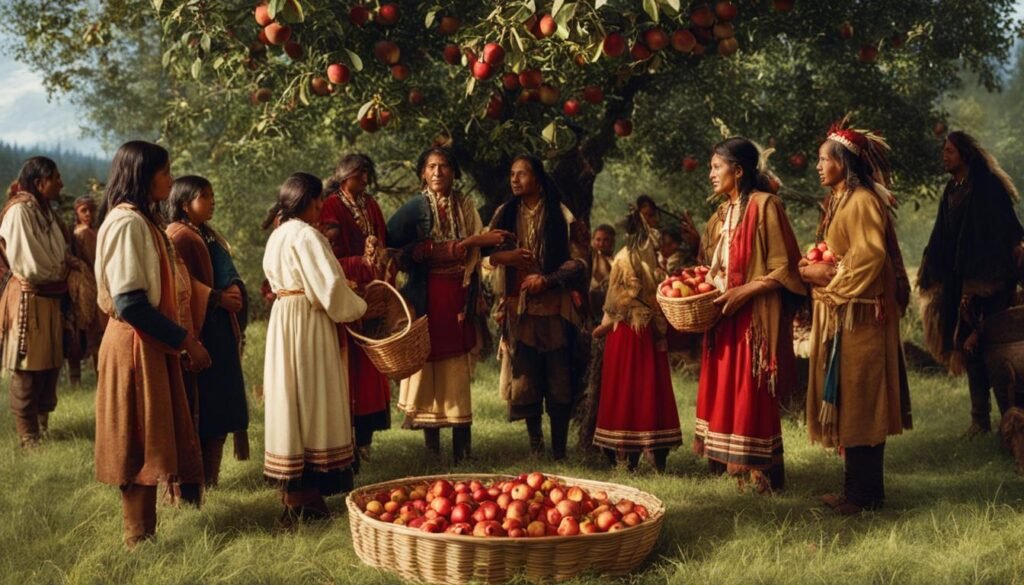
Medicinal and Spiritual Significance:
For Native American tribes, apple trees were not only a source of sustenance but also held medicinal and spiritual significance. The bark, leaves, and fruit of the apple tree were used in various remedies and herbal preparations. The apple tree was believed to possess healing properties and was often used to treat ailments such as digestive issues, respiratory problems, and skin conditions.
Celebration of Nature:
Native American cultures have a deep respect and reverence for nature, and the apple tree was no exception. The apple tree’s ability to thrive and bear fruit symbolized the abundance and resilience of the natural world. It was often celebrated in ceremonies and rituals as a way to honor and connect with the earth and its cycles.
Interconnectedness with the Land:
Johnny Appleseed’s interactions with Native Americans went beyond just planting apple trees. He also cultivated relationships, fostering friendships based on mutual respect and admiration for the land. By planting not only apple trees but also medicinal plants and herbs, Johnny showed his understanding of the interconnectedness between humans, nature, and the land. This relationship highlights the cultural significance of apple trees in Native American folklore.
| Native American Connections to Apple Trees | |
|---|---|
| Medicinal and Spiritual Significance | The apple tree was used in remedies and held spiritual symbolism. |
| Celebration of Nature | Apple trees were honored in ceremonies as a symbol of abundance. |
| Interconnectedness with the Land | Johnny Appleseed fostered friendships and admiration for the land. |
Apple Tree Symbolism and Superstitions
Throughout history, apple trees have been imbued with rich symbolism and surrounded by intriguing superstitions. These beliefs and interpretations have shaped the cultural significance of apple trees in various societies. The symbolism associated with apple trees often centers around themes of knowledge, temptation, and immortality.
In folklore, the apple is frequently connected to the biblical story of the Garden of Eden, where it represents the forbidden fruit that led to humanity’s fall from grace. This association has given the apple a reputation as a symbol of knowledge and temptation.
“The apple is a symbol of knowledge, of wisdom, and of immortality, and also of love and fertility. It is the fruit of Venus, of the Norse goddess Iðun and of the Celtic goddess Olwen. In Norse mythology, the goddess Iðun had golden apples which kept the gods youthful.”
Additionally, apple trees are believed to bring good luck and protection from evil spirits. In some cultures, it is customary to plant an apple tree in the garden to ensure good fortune and ward off negative energies. Furthermore, apple trees have been associated with fertility and abundance, with the blossoming of apple trees considered a sign of prosperity and a bountiful harvest.
Understanding the symbolism and superstitions surrounding apple trees provides fascinating insights into the cultural significance and enduring appeal of these majestic trees.
| Symbolism | Superstitions |
|---|---|
| The apple as a symbol of knowledge and temptation | Planting apple trees for good luck and protection from evil spirits |
| The apple as a symbol of immortality and love | Belief in the fertility and abundance associated with apple trees |
| The apple as a symbol of youth and vitality | The blossoming of apple trees as a sign of prosperity and a bountiful harvest |
As we explore the world of apple tree folklore, we uncover the diverse and captivating stories, legends, and beliefs surrounding these remarkable trees. From their symbolism to the superstitions they inspire, apple trees continue to enchant and fascinate us, drawing us closer to the natural world and the rich cultural heritage they embody.
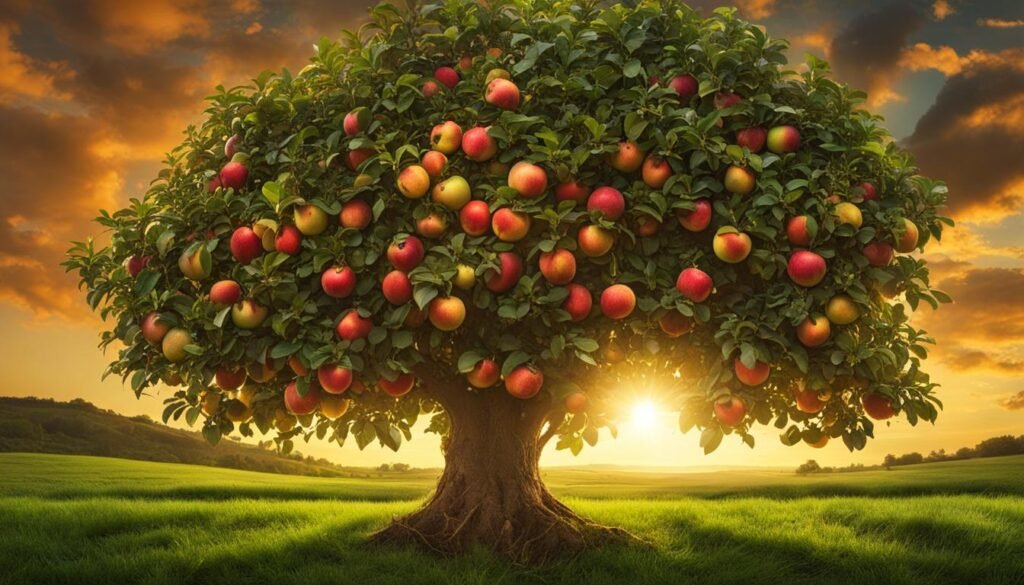
Mythical Legends of Apple Trees
Apple trees have long been the subject of mythical legends and stories in various cultures across the United States. These enchanting tales add to the rich tapestry of apple tree folklore, captivating imaginations and offering glimpses into the cultural diversity of America.
One such legend is the story of the Junaluska apple, associated with a Cherokee Chief and a land purchase. According to the tale, Chief Junaluska offered a unique apple tree as payment for a piece of land. The tree, known for its exceptional qualities and distinct flavor, became a symbol of the Chief’s generosity and respect for nature.
In other legends, magical apple trees are said to grant wishes or lead to hidden treasure. These stories highlight the mystical and symbolic nature of apple trees, representing desires, abundance, and the hidden wonders of the natural world. They reflect the enduring fascination and wonder that people have for these iconic trees.
Exploring these mythical legends of apple trees not only entertains and captivates but also provides insights into the imaginative spirit and cultural significance that these trees hold in different parts of the United States.
| Mythical Legends of Apple Trees | Region/Culture |
|---|---|
| The Junaluska Apple | Cherokee |
| Magical Apple Trees | Various regions |
| … | … |
Table: Some examples of mythical legends of apple trees in the United States.
The Junaluska Apple: A Cherokee Legend
“The Junaluska apple tree, revered by the Cherokee people, symbolizes the generosity and respect for nature of Chief Junaluska. Its distinct flavor and exceptional qualities continue to be celebrated in Cherokee folklore.”
Magical Apple Trees: Granting Wishes and Hidden Treasures
“In various regions across the United States, mythical stories of magical apple trees have been passed down through generations. These captivating tales depict apple trees as vehicles for wish fulfillment and gateways to hidden treasures.”
Apple Trees in Art and Literature
Throughout history, apple trees have served as a muse for artists and writers, inspiring captivating works of art and literature. Paintings portraying the beauty and abundance of apple trees have adorned galleries and museums, while books and poems have woven their symbolism into the fabric of storytelling. The allure of apple trees lies in their connection to nature, growth, knowledge, and self-discovery.
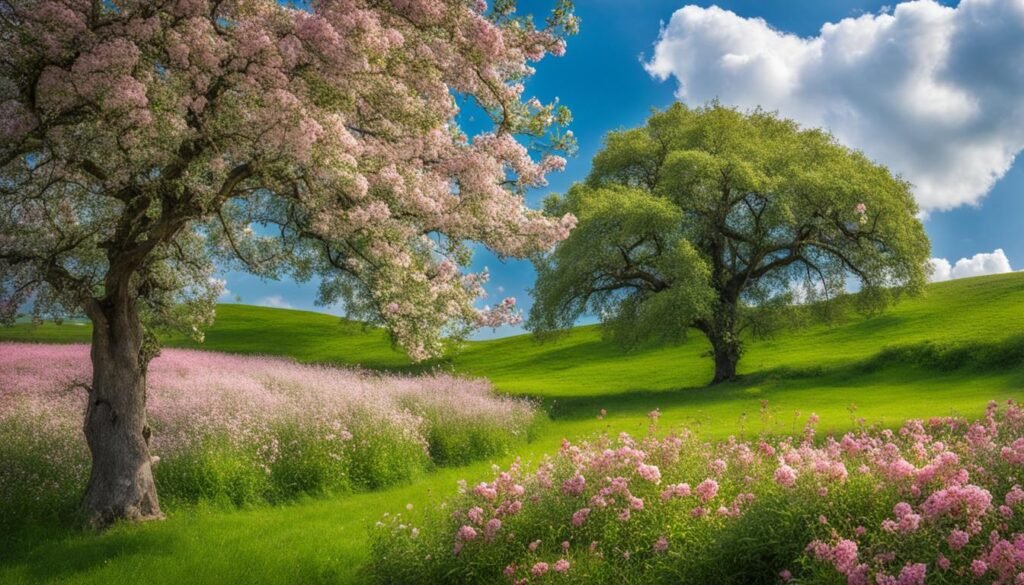
In the realm of art, renowned painters have sought to capture the essence of apple trees on canvas. Vincent van Gogh’s masterpiece “The Mulberry Tree” depicts a vibrant apple tree in full bloom, radiating with vivid colors and embodying the artist’s profound connection to nature. The painting showcases the tree’s symbolism as a representation of life, fertility, and the cycle of seasons.
“The poetry of earth is never dead: When all the birds are faint with the hot sun, And hide in cooling trees, a voice will run From hedge to hedge about the new-mown mead…” – John Keats
In literature, apple trees have been a recurring motif, often symbolizing personal growth, knowledge, and self-reflection. Shel Silverstein’s beloved children’s book, “The Giving Tree,” explores themes of love, sacrifice, and the cycle of life through the protagonist, an apple tree. The tree serves as a metaphor for the human capacity to give unconditionally and the beauty of finding fulfillment in selflessness.
Inspiring Creativity in Every Branch
The presence of apple trees in art and literature goes beyond their aesthetic appeal. They evoke a sense of wonder, inviting us to contemplate the beauty of nature and the interconnectedness of all living things. The symbolism of apple trees resonates with readers and viewers, encouraging introspection and contemplation of life’s deeper meaning.
By portraying apple trees in various artistic mediums, artists and writers pay homage to the enduring cultural significance of these trees. They remind us of our connection to the natural world and the wisdom passed down through generations. Through their work, they invite us to celebrate the beauty of apple trees and embrace the profound symbolism they represent.
Apple Tree Festivals and Celebrations
Apple tree festivals and celebrations are a wonderful way to honor the rich cultural significance of these iconic trees. These events bring communities together to celebrate the harvest season and showcase the enduring beauty and importance of apple trees in American culture.
During apple tree festivals, attendees can participate in a variety of apple-themed activities that pay homage to the folklore and traditions associated with these trees. One popular activity is apple picking, where visitors can enjoy the experience of selecting their own ripe apples straight from the tree. It’s a delightful way to connect with nature and appreciate the bounty of the harvest.
Cider pressing is another highlight of apple tree festivals, where attendees can witness the traditional process of turning freshly harvested apples into delicious cider. This hands-on activity allows participants to learn about the historical significance of apple trees in providing sustenance and refreshment for early settlers.
Furthermore, apple pie baking contests are often held at these festivals, bringing out the creativity and culinary skills of participants as they vie for the title of the best apple pie. These contests showcase the versatility of apples in culinary traditions and allow visitors to indulge in mouthwatering tastes and flavors.
The rich cultural tapestry of apple tree folklore is celebrated through historical reenactments, where stories and legends are brought to life. These performances transport attendees back in time, offering glimpses into the past and the enduring legacy of apple tree traditions.
Table: Apple Tree Festival Activities
| Activities | Description |
|---|---|
| Apple Picking | Visitors can pick their own apples from orchards, savoring the experience of harvesting fresh fruit. |
| Cider Pressing | Witness the traditional process of turning apples into cider, learning about historical methods and techniques. |
| Apple Pie Baking Contests | Participants compete in baking the best apple pie, showcasing their culinary skills and creativity. |
| Historical Reenactments | Performances bring the stories and legends of apple tree folklore to life, offering a glimpse into the past. |
Apple tree festivals and celebrations provide a platform to honor the cultural significance of these trees and recognize their contributions to American heritage. These events not only bring communities together but also serve as a reminder of our connection to nature and the importance of preserving traditions for future generations.

Conservation efforts often involve locating and documenting rare apple tree cultivars, which may have unique characteristics or historical associations. These varieties are carefully cultivated and propagated, preserving their genetic traits and ensuring their longevity. By maintaining a diverse collection of apple tree cultivars, conservationists contribute to the overall health and resilience of apple tree populations and the ecosystems they support.
Preservation also plays a crucial role in honoring the cultural heritage associated with apple trees. Many historic apple tree varieties have deep roots in local communities, representing a shared history and sense of identity. By protecting these trees, we preserve the stories and traditions ingrained within them, recognizing the contributions they have made to our collective heritage.
Table: Rare Apple Tree Cultivars
| Apple Variety | Region | Historical Significance |
|---|---|---|
| Esopus Spitzenburg | Hudson Valley, New York | Favored by Thomas Jefferson |
| Arkansas Black | Arkansas | Popular for its long storage life |
| Roxbury Russet | Massachusetts | One of America’s oldest apple varieties |
| Grimes Golden | West Virginia | Believed to be the parent of the Golden Delicious |
Through apple tree conservation and preservation, we ensure that future generations can continue to connect with the rich folklore and historical beliefs surrounding these iconic trees. By protecting rare apple tree cultivars and honoring their cultural significance, we pay homage to the past while embracing the future of apple tree folklore.
Apple Tree Folklore in Modern Society
Apple tree folklore continues to captivate and inspire in modern society, reminding us of our connection to nature and the rich tapestry of American culture. The stories, legends, and beliefs surrounding apple trees have evolved over time, but their cultural significance remains strong. People still appreciate the beauty and symbolism of apple trees, and these enduring tales continue to hold a special place in our hearts.
From their association with knowledge, temptation, and immortality in biblical stories to their role as symbols of growth, self-discovery, and resilience in literature, apple trees continue to be a subject of fascination in art and literature. Artists and writers draw inspiration from their beauty and abundance, using them as a metaphor for the human experience.
In modern society, apple tree festivals and celebrations are held in many communities across the United States to honor the cultural significance of these trees. These events bring people together to celebrate the harvest, partake in apple-themed activities, and showcase the importance of apple trees in American culture. From apple picking to cider pressing and historical reenactments, these festivals serve as a reminder of the traditions and wisdom passed down through generations.
As we continue to celebrate and preserve apple tree folklore, we ensure that future generations can appreciate and learn from these enchanting stories. Efforts are being made to conserve and protect historic apple tree varieties, preserving their unique characteristics and cultural heritage. By doing so, we honor the past and continue to pass down the traditions and values associated with apple trees.
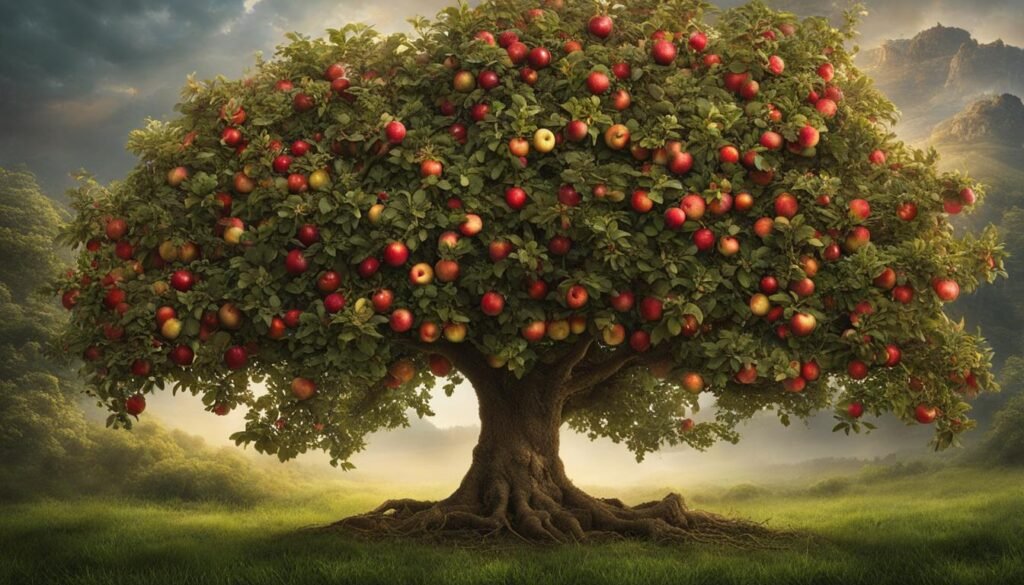
Apple Tree Folklore in Modern Society
“The stories and legends surrounding apple trees continue to inspire and captivate, reminding us of our connection to nature and the rich tapestry of American culture.”
Apple tree folklore remains a cultural touchstone, offering a glimpse into our nation’s history and values. So let us immerse ourselves in the colorful world of apple tree folklore and discover the wisdom and traditions that have shaped America’s cultural heritage.
Exploring Apple Tree Folklore Around the U.S.
Apple tree folklore varies across different regions of the United States, reflecting the unique history and cultural heritage of each area. From New England with its colonial apple tree traditions to the Midwest and its association with Johnny Appleseed, each region has its own tales of apple tree legends, myths, symbolism, and superstitions. Exploring these regional variations allows us to discover the diverse and fascinating world of apple tree folklore.
In New England, apple tree folklore is deeply rooted in the region’s colonial history. The apple orchards of Massachusetts, Connecticut, and Vermont tell stories of early settlers who relied on apple trees for sustenance and trade. These trees were a symbol of resilience and provided a vital food source for the colonists.
In the Midwest, the folklore surrounding apple trees is intertwined with the mythic figure of Johnny Appleseed. Legends of Johnny’s travels, planting apple seeds, and creating orchards have become an integral part of apple tree folklore in this region. His legacy continues to be celebrated through festivals and events that honor the cultural significance of apple trees.
| Region | Main Apple Tree Folklore |
|---|---|
| New England | Colonial apple orchards as a symbol of resilience |
| Midwest | Legends of Johnny Appleseed and his apple tree plantings |
| South | Apple tree superstitions and magical legends |
| West Coast | Apple tree symbolism in art and literature |
In the South, apple tree folklore often revolves around superstitions and magical legends. Some believe that burying apple seeds before a full moon can bring good luck, while others claim that hanging an apple from a tree branch can ward off evil spirits. These beliefs showcase the deep-rooted connection between apple trees and the supernatural.
On the West Coast, apple tree folklore takes on a different form, as it is often represented in art and literature. Paintings of apple trees capture the beauty of nature, while literary works use apple trees as symbols of growth and knowledge. From the stunning landscapes depicted by California artists to the powerful imagery in John Steinbeck’s “The Grapes of Wrath,” apple trees continue to inspire and captivate in this region.
As we explore these regional variations in apple tree folklore, we gain a deeper understanding of the cultural significance and rich history associated with these iconic trees. Whether it’s through legends of Johnny Appleseed, superstitions in the South, or artistic representations on the West Coast, apple tree folklore offers a window into the diverse stories and traditions that have shaped America’s cultural tapestry.
Conclusion
As I wrap up this exploration of apple tree folklore, I am reminded of the incredible richness and depth of stories, legends, and beliefs that have shaped America’s cultural heritage. From the enchanting tale of “The Apple Tree’s Discovery,” teaching us the importance of self-acceptance, to the enduring legacy of Johnny Appleseed, who valued nature and compassion, apple tree folklore captures the essence of our nation’s history and values.
Apple trees played a vital role in early America, symbolizing resilience and adaptation. They were not only a source of sustenance but also a means of claiming land and fostering relationships with Native Americans. These trees were imbued with symbolism and superstitions, representing knowledge, temptation, fertility, and protection. They continue to inspire artists and writers, appearing in paintings and literature as symbols of growth, self-discovery, and abundance.
Exploring apple tree folklore across different regions of the United States reveals a diverse tapestry of stories, legends, and beliefs. From colonial apple tree traditions in New England to the association with Johnny Appleseed in the Midwest, each region has its own unique tales to tell. By celebrating and preserving apple tree folklore, we honor the traditions and wisdom of our ancestors, passing down these enchanting stories to future generations.
Immerse yourself in the colorful world of apple tree folklore and discover the enchantment of these iconic trees. Their significance goes beyond their physical presence, connecting us to our past and reminding us of the beauty and wisdom found in nature. As we appreciate and protect these trees, we ensure that apple tree folklore remains an integral part of our cultural heritage for years to come.
FAQ
What is apple tree folklore?
Apple tree folklore refers to the stories, legends, myths, symbolism, and superstitions associated with apple trees that have been passed down through generations in American culture.
What are some examples of apple tree folklore?
Examples of apple tree folklore include the myth of “The Apple Tree’s Discovery,” the legend of Johnny Appleseed, and various regional tales of magical apple trees and hidden treasures.
What is the significance of apple trees in early America?
In early America, apple trees played a vital role as settlers were allowed to claim land by planting apple or pear trees. Apple orchards became a significant part of the landscape, with apples being used to make hard cider as a safer alternative to drinking water.
How did Native Americans connect with apple trees?
Native Americans recognized the value of apple trees and had their own connections to them. Johnny Appleseed’s interactions with Native Americans involved not only planting apple trees but also fostering friendships and showing respect for the land and its native inhabitants.
What symbols and superstitions are associated with apple trees?
Apple trees have been associated with symbols of knowledge, temptation, and immortality. Superstitions surrounding apple trees include beliefs that they bring good luck, fertility, and protection from evil spirits.
How have apple trees been depicted in art and literature?
Apple trees have been a source of inspiration for artists and writers, appearing in paintings and literature as symbols of growth, knowledge, and self-discovery. Famous examples include Van Gogh’s “The Mulberry Tree” and Shel Silverstein’s “The Giving Tree.”
Do communities hold festivals to honor apple trees?
Yes, many communities across the United States hold apple tree festivals and celebrations to honor the cultural significance of these trees. These events often feature apple-themed activities such as apple picking, cider pressing, and historical reenactments.
Why is apple tree conservation important?
Efforts are being made to conserve and preserve historic apple tree varieties as they are part of our cultural heritage. Conserving these trees ensures their survival for future generations and helps maintain our connection to the past.
What is the cultural significance of apple tree folklore in modern society?
Apple tree folklore continues to be celebrated and appreciated in modern society. The stories, legends, and beliefs associated with apple trees serve as a reminder of our connection to nature, our heritage, and the diverse culture of America.
How does apple tree folklore vary across different regions of the United States?
Apple tree folklore varies across different regions, reflecting the unique history and cultural heritage of each area. Each region has its own tales of apple tree legends, myths, symbolism, and superstitions.
Where can I learn more about apple tree folklore?
To learn more about apple tree folklore, you can explore books, articles, and local resources that delve into the rich tapestry of stories, legends, and beliefs surrounding these iconic trees.
